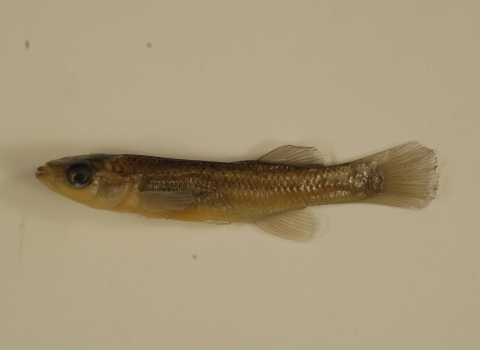In the late 1980s the future for the black-capped vireo, a striking songbird that breeds only in Oklahoma and Texas and northernmost Mexico, looked bleak. Only about 350 birds were known to survive in a few locations. Following the bird’s listing under the Endangered Species Act (ESA) in 1987, the Service began working with the states of Oklahoma and Texas, the U.S. Army, private landowners and non-governmental organizations to protect and recover the vireo. There are now more than 5,200 known birds and more than 14,000 estimated across their breeding range. Thanks to the dedication and perseverance of our partners, the Service is able to announce that we are proposing to delist the black-capped vireo from the ESA due to recovery.
“The commitment and follow-through from Fort Hood, Fort Sill, Texas Parks and Wildlife Department, Oklahoma Department of Wildlife Conservation, private landowners and others over the last 30 years have been critical in bringing the vireo back from the brink of extinction,” said Dr. Benjamin N. Tuggle, the Service’s Southwest Regional Director. “Today’s announcement illustrates exactly how the ESA works to protect species on the brink of extinction and to successfully recover them.”
"The training and readiness of our Soldiers continues to be my top priority, and I applaud the cooperation between the U.S. Fish and Wildlife Service and Fort Hood's Natural Resources team to protect Fort Hood's ability to accomplish our mission while balancing environmental stewardship,” said Lieutenant General Sean McFarland, Commanding General, III Armored Corps and Fort Hood. “The effort to potentially delist the black capped vireo as an endangered species is indicative of the strong and effective partnership between the Service and Fort Hood."
The decline of the black-capped vireo was primarily due to the impacts of habitat loss and nest parasitism by brown-headed cowbirds who dupe the vireos into raising cowbird chicks at the cost of the survival of their own young. Across the species’ U.S. range, our partners are addressing and reducing the threats to the vireo through the use of prescribed fire, conservation easements, and management of brown-headed cowbirds. The U.S. Army manages significant populations of the species in Texas and Oklahoma, where it has protected important vireo habitat and breeding grounds and managed primary threats. Texas and Oklahoma have provided funding for research and recovery, and successfully managed vireo populations on state lands. Private landowners are participating in state cowbird control programs and managing lands to promote native habitats for the species. The USDA’s Natural Resources Conservation Service and conservation groups including The Nature Conservancy and Environmental Defense Fund have also contributed to the recovery of the vireo by promoting private land management, reducing threats on private lands, and protecting habitat through easements and acquisition.
The black-capped vireo is the smallest member of the vireo family occurring regularly in the Unites States. It winters exclusively in Mexico along the Pacific Coast. Sporting a namesake black cap and white face mask, black-capped vireos build intricate hanging cup nests two to four feet above the ground fastened to the branches of shrubs with strands from spider webs, and return to the same breeding site year after year.
In June 2007, the Service completed a five-year status review of the species that recommended it be downlisted. We received a petition in 2012 to downlist the bird and in September 2013 we published a 90-day finding that the petition presented substantial information that downlisting may be warranted. The Service used a Species Status Assessment to evaluate species status and address the petition. Our analysis of the best available science indicates the primary known threats to the black-capped vireo, of habitat loss and brown-headed cowbird parasitism, have been reduced or adequately managed and populations are expected to be viable in the future. As such, the vireo no longer meets the definition of a threatened or endangered species under the ESA.
If the vireo is delisted, the Service would continue to work with partners to monitor its status for a minimum of five years after delisting. A post-delisting monitoring plan will describe monitoring methods, reporting procedures and agency responsibilities, and be published in draft form for public comment prior to the final delisting rule.
The Service is requesting comments or information from the public, other concerned governmental agencies, the scientific community, industry, or any other interested parties concerning the delisting proposal. Comments must be received within 60 days, on or before February 13, 2017. You may submit comments by one of the following methods:
(1) Electronically: Go to the Federal eRulemaking Portal: http://www.regulations.gov. In the Search box, enter FWS-R2-ES-2016-0110 which is the docket number for this rulemaking. Then, in the Search panel on the left side of the screen, under the Document Type heading, click on the Proposed Rules link to locate this document. You may submit a comment by clicking on “Comment Now!”
(2) By hard copy: Submit by U.S. mail or hand-delivery to: Public Comments Processing, Attn: FWS-R2-ES-2016-0110; U.S. Fish & Wildlife Headquarters, MS: BPHC, 5275 Leesburg Pike, Falls Church, VA 22041-3803.
America’s fish, wildlife, and plant resources belong to all of us, and ensuring the health of imperiled species is a shared responsibility. We’re working to actively engage conservation partners and the public in the search for improved and innovative ways to conserve and recover imperiled species.



